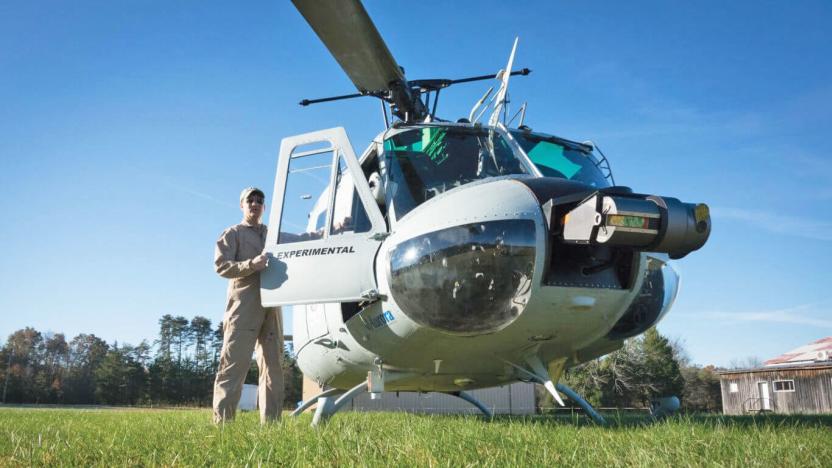helicopter
Latest

Watch Will Smith's Grand Canyon helicopter bungee jump at 6 PM ET
Of all the things you could possibly be doing on a Tuesday afternoon, watching a live stream of Will Smith bungee jumping out of a helicopter is probably not among the worst. Oh, and he's doing the stunt over the Grand Canyon on his 50th birthday. No biggie. The multi-hyphenate megastar is celebrating his big day in Big Willie Style, and you can watch the jump as it happens, because YouTube is airing it as one of its originals.

Autonomous helicopter makes first operational delivery to Marines
Drones are coming to the battlefield faster than you think. Aurora Flight Sciences recently unveiled an autonomous, LiDAR equipped helicopter called AACUS, which was already an impressive feat, considering a helicopter's complexity. Now, for the first time, it has completed an autonomous, closed-loop cargo mission, delivering gas, water and medical supplies to US Marines during an integrated training exercise in California.

NASA is sending its first autonomous helicopter to Mars in 2020
The next vehicle NASA is sending to Mars nestles somewhere between a rover and a satellite, at least in terms of altitude. The agency is bundling an autonomous helicopter with the Mars 2020 rover to test airborne vehicles on the red planet.

AT&T's 'Flying COW' drone provides cell service to Puerto Rico
These days, it's just as important to have communication up and running after a major disaster as it is to have power, food and drinkable water. The FCC approved $77 million to fix communications in Puerto Rico and the US Virgin Islands, while Project Loon (a collaboration with AT&T, Alphabet and T-Mobile) has found ways to get the internet up and running via LTE-providing balloons. Now, AT&T has deployed its helicopter Flying COW (Cell on Wings) to temporarily provide data, voice and text services to Puerto Rico in the aftermath of Hurricane Maria.

US Army wants helicopters to refuel at robotic pumps
Militaries regularly set up fueling stations at forward bases so that helicopters can get back to the fight as quickly as possible. However, requiring fuel crews creates huge risks and logistical headaches: you're sending people to a dangerous, isolated section of the battlefield for a fairly mundane role. Thankfully, the US Army might not need to take that risk for much longer. It's testing an unmanned station, the Autonomous & Robotic Remote Refueling Point (AR3P for short), that can top up a helicopter with no human involvement. Much like Tesla's robotic charger, it would use self-aligning, articulated arms to hook a fuel line to a helicopter all by itself. That, in turn, would let helicopters fly at all hours without putting footsoldiers in harm's way, and would likely refuel them faster.

The Army is flight testing helicopter-mounted laser weapons
The US military's experiments shooting lasers from vehicles continue with another important milestone: Laser-equipped attack helicopter fired at targets for the first time. The US Army keeps getting better at nailing UAV targets with ground-based truck lasers, but it's harder to fire accurately from helicopters. Not only does their position fluctuate with airborne conditions, but their whole frame vibrates as their rotors spin fast enough to keep the whole vehicle aloft. Hitting a target almost a mile away from the air, as the Army just accomplished in a New Mexico tests series, is a big deal.

Airbus imagines a faster helicopter with wings
Airbus has showed off a new helicopter concept at the Paris Airshow that could give operators everything they want: speed, versatility and economy. The Racer (rapid and cost-effective rotorcraft) features a main rotor like a regular helicopter, but uses pusher propellers to accelerate it forward and a new "box-wing" system for extra lift. As a result, it'll power along at up to 400 km/h (250 mph) while being able to take off on a dime like a regular chopper.

E-volo's electric 'air taxi' picks up passengers next year
The last time we'd heard about E-Volo's 18-rotor electric helicopter was almost a year ago to the day. The latest news out of the company is that at AERO, an aviation trade show in Germany, E-Volo revealed its latest model, the Volocopter 2X. The firm says that the advantages of this version versus previous iterations (namely, the VC200) are that it's a "consequent evolution" geared toward everyday use as an autonomous urban mobility vehicle. Translation: it could be a pilot-free, or remote-flown taxi for two.

Drone flies as both biplane and helicopter using one propeller
There are helicopter drones and fixed-wing drones, but creating a hybrid of both is tricky. Even Parrot's Swing, as clever as it is, needs four propellers and elaborate wings to pull off its stunt. However, TU Delft (with backing from Parrot) has a far more elegant solution. Its DelftAcopter drone doubles as both a fixed-wing aircraft and a helicopter using only one propeller -- its tailless biplane design lets it take off and hover vertically, but gracefully turn into a fast-moving airplane (up to 62MPH) at a moment's notice. It's an incredibly simple design that makes you wonder why someone hadn't considered it for drones before.

Software predicts the lifespans of machines by 'cloning' them
In some cases, machine breakdowns are more than just inconveniences -- in the military, they can spell disaster on the battlefield. Software is quickly eliminating those rude surprises, however. NASA spinoff Sentient Science has been offering DigitalClone, a software tool that predicts failures by 'cloning' parts. It uses an understanding of the physics of a given part, such as friction and wear, to determine when that gear is likely to break. The clone is uncannily accurate (Sentient Science has sensors to confirm its data), making it easy to extend the lifespan of a device by replacing parts before there's a crisis.

Watch an 18-rotor electric helicopter take its first manned flight
E-Volo has been talking about the prospect of using many-rotor electric helicopters (aka multicopters) as semi-affordable personal transport for years, and it now looks like this isn't just a far-fetched dream. The company recently completed the first manned test flight of the first certified multicopter, the Volocopter VC200, and documented the whole affair on camera. It wasn't the most ambitious flight, as you'll see in the clips below, but it shows exactly what the extremely stable, drone-like vehicle can do. You don't need to constantly monitor the controls to keep the VC200 airborne, making it perfect for newcomers.

Uber deal with Airbus gives you more helicopter rides
It might not be long before Uber helicopter rides are more than just expensive novelties. Uber has forged a deal that has Airbus supplying helicopters for a transportation test project launching in "several weeks." Details of how it'll work aren't available just yet, but the hope is that this will lower the cost of Uber-by-air options -- they may eventually be inexpensive enough that you can realistically take a chopper when a normal ride would be inconvenient (or just plain boring). The pact isn't surprising given Uber's recent attempts to diversify beyond cars, but it's welcome all the same. [Image credit: Eric Piermont/AFP/Getty Images]

ICYMI: Airbag moto-jacket, robotic landing gear and more
#fivemin-widget-blogsmith-image-582118{display:none;} .cke_show_borders #fivemin-widget-blogsmith-image-582118, #postcontentcontainer #fivemin-widget-blogsmith-image-582118{width:570px;display:block;} try{document.getElementById("fivemin-widget-blogsmith-image-582118").style.display="none";}catch(e){}Today on In Case You Missed It: Newly unveiled robotic landing gear is enabling helicopters to land on uneven ground. But that's DARPA for you; always down with the militarized robot inventions. Meanwhile motorcyclists have a new jacket that not only looks legit but uses sensors to deploy an internal airbag if danger is detected. And a Kickstarter project for the SteadXP is interesting because it can make give most digital cameras a steadicam look, no matter how shaky or untrained the operator.

DARPA gives an R/C chopper the legs of a dragonfly
DARPA has revealed a new kind of landing gear that allows helicopters to land on inclines and uneven terrain, a feat that's generally impossible using traditional landing skids. Rather than the fixed landing gear that most helicopters sport, this new set of four articulated legs is designed to work much like an insect's. Each leg is outfitted with force feedback sensors that tells it how much pressure to exert in order to keep the aircraft level, regardless of terrain.

Lockheed Martin buys helicopter maker Sikorsky
Don't look now, but Lockheed Martin just became an even larger aerospace powerhouse. The aircraft maker has acquired helicopter maker Sikorsky (best known for the UH-60 Blackhawk) for $9 billion. The two have already been partners on programs like the MH-60, but this gives Lockheed its very own rotary-wing team. If a customer wants something that flies, the company will have it covered. The buyout is poised to close by late 2015 or early 2016, provided everything goes smoothly.

Unmanned cargo chopper shows off its search-and-rescue talents
For three years between 2011 and 2014, the unmanned Kamen K-Max 1200 helicopter delivered more than 4.5 million tons of supplies to the most dangerous and far-flung US Forward Operating Bases throughout Afghanistan. It followed that feat up in 2014 by demonstrating its ability to coordinate with other UAVs in forest fire suppression operations. And in March of this year, the semi-autonomous helicopter once again proved that it can integrate operations with land-based drones to locate, identify and evacuate people stranded in desolate areas -- all without putting more lives at risk.

Ultrathin membrane makes plane cabins 100x quieter
While air travel is quicker and safer than driving, it's also louder. The continuous low-frequency drone of the engines is why some people invest in noise-canceling headphones. To help reduce that non-stop hum, researchers at North Carolina State University and MIT have developed a thin membrane to be inserted into the lightweight honeycomb structure of planes and helicopters. "At low frequencies – sounds below 500 Hertz – the honeycomb panel with the membrane blocks 100 to 1,000 times more sound energy than the panel without a membrane." said Yun Jing, an assistant professor of mechanical and aerospace engineering at NC State University. The 0.25mm-thick membrane would only add an additional six percent to the overall weight of the honeycomb structure of aircraft. While that doesn't seem like much, every ounce counts to airlines trying to maximize flight costs. It'll be on them to decide whether they'd rather save money on fuel or makes cabins a better place for passengers.

Gotham Air is the helicopter taxi you can order from your smartphone
Gotham Air, a new ride-sharing service in New York City, has released its iOS and Android apps to the general public. They probably won't be replacing Uber or Lyft in most people's lives though, because as the name suggests, Gotham Air rents out helicopters not cars. Plus, its choppers only fly from Manhattan's Downtown Heliport to either JFK or Newark airport, and passengers can only have one 25-pound carry-on bag with them. The apps are easy enough to use, though: just sign up for an account, reserve a seat for $219 each (the service sometimes offers an introductory price of $99 for certain times of the day) and pay via credit card.

NASA wants helicopter drones to lead the way for Mars rovers
Rovers have a tough time getting across Mars' vast, unforgiving landscape. They can't see very far ahead, and the crew back home can only offer so much help by looking at orbital imagery. NASA's Jet Propulsion Laboratory may have a clever solution to that problem, though: an aerial robot scout. Its proposed Mars Helicopter drone would fly ahead of rovers and give operators a much better view of the Martian terrain, helping them plot the quickest route to interesting locales. It could even find a safe spot to deposit samples that future rovers would pick up.

Fuel Burner hovers and lands
Fuel Burner is a free game currently available for iPhone, iPad, and iPod touch and is optimized for iPhone 5. The goal of the game is to land all the helicopters in each level on landing pads marked with an "H" and landing on roofs in between to get there. By clicking on the helicopter, you can begin to move from one roof to another by clicking on them until you reach your landing. A user cannot land on the same roof twice and must use exactly the number of fuel power ups before landing on the helipads. This game does not allow a user to purchase more fuel. However, the user is encouraged to tell friends about the game in exchange for more 10 power up units. That seems fair enough and a pretty good way for the developer to get the word out about the game without having to pay for advertising. The graphics are very basic. For a free game that does not have any in app purchases available, expectations are pretty low anyways but they are quite underwhelming. The graphics seem to be for boys under the age of 12. 90 degree angles, basic color palette, and simple 3D graphics make it seem like it's a game targeted towards a "Lego" demographic. I could see kids between the ages of 5 and 12 finding this app visually appealing. I personally know a lot of kids who are big fans of helicopters and would be interested in giving this game a try. There are three difficulty settings - "Beginner" allows a user an unlimited amount of time to land all of the helicopters. "Intermediate" gives a 5 minute time limit, and expert provides only 3 minutes. I don't consider myself to be an expert player by any means, but I beat all of the levels even on the expert setting with very little difficulty. This game is not challenging but is a good way to pass the time on a train or while waiting in line. It doesn't require much focus especially on the beginner setting which does not have a time limit. The app describes itself as "A 5-star FUN strategic challenge, just don't get addicted!!" Very cute reverse psychology tactic, but didn't work on me. I like a game to be more challenging and dynamic. Every level is pretty much the same appearance wise and the only real obstacle is time. The number of fuel power-ups I think is supposed to be an obstacle but it's too easy to work around to be considered one in my opinion. Fuel Burner might be incredibly easy for some, but less experienced game players might find it very addictive. Helicopter fans of all ages, try it out but just don't get addicted!










